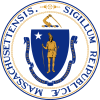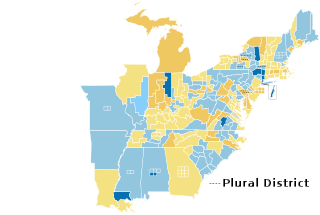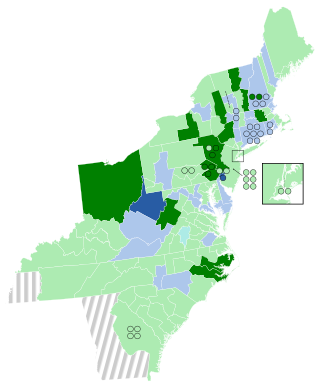| Elections in Massachusetts |
|---|
 |
Massachusetts required a majority for election. This was not met in the 5th district and 7th district necessitating additional ballots in those districts.
| District | Incumbent | Party | First elected | Result | Candidates |
|---|---|---|---|---|---|
| Massachusetts 1 "1st Western district" | Thomson J. Skinner | Democratic- Republican | 1796 (Special) | Incumbent retired. New member elected. Federalist gain. | √ Theodore Sedgwick (Federalist) 80.2% Thomas Ives (Democratic-Republican) 19.8% |
| Massachusetts 2 "2nd Western district" | William Shepard | Federalist | 1797 | Incumbent re-elected. | √ William Shepard (Federalist) 89.9% John Williams (Democratic-Republican) 10.1% |
| Massachusetts 3 "3rd Western district" | Samuel Lyman | Federalist | 1794 | Incumbent re-elected. | √ Samuel Lyman (Federalist) 88.4% Daniel Bigelow 6.4% Scattering 5.2% |
| Massachusetts 4 "4th Western district" | Dwight Foster | Federalist | 1793 | Incumbent re-elected. | √ Dwight Foster (Federalist) 80.8% Levi Lincoln Sr. (Democratic-Republican) 19.2% |
| Massachusetts 5 "1st Southern district" | Nathaniel Freeman Jr. | Democratic- Republican | 1794 | Incumbent retired. New member elected. Federalist gain. | First ballot (November 5, 1798): Lemuel Williams (Federalist) 32.5% Macajah Coffin (Democratic-Republican) 30.4% Beriah Norton (Federalist) 17.4% Jonathan Moore (Federalist) 13.4% Scattering 6.3% Second ballot (January 17, 1799): Macajah Coffin (Democratic-Republican) 33.5% Lemuel Williams (Federalist) 30.1% Sam Savage 27.1% Beriah Norton (Federalist) 9.3% Third ballot (April 1, 1799): Lemuel Williams (Federalist) 36.5% Sam Savage 33.9% Macajah Coffin (Democratic-Republican) 29.5% Fourth ballot (June 6, 1799): Lemuel Williams (Federalist) 46.6% Sam Savage 27.2% Macajah Coffin (Democratic-Republican) 26.2% Fifth ballot (August 29, 1799): √ Lemuel Williams (Federalist) 74.8% Macajah Coffin (Democratic-Republican) 25.2% |
| Massachusetts 6 "2nd Southern district" | John Reed Sr. | Federalist | 1794 | Incumbent re-elected. | √ John Reed Sr. (Federalist) 58.0% John Dwight 26.9% Daniel Snow 15.1% |
| Massachusetts 7 "3rd Southern district" | Stephen Bullock | Federalist | 1797 | Incumbent lost re-election. New member elected. Democratic-Republican gain. | First ballot (November 5, 1798): Stephen Bullock (Federalist) 26.9% Laban Wheaton (Federalist) 25.7% Josiah Dean 23.6% Phanuel Bishop (Democratic-Republican) 11.8% Scattering 12.1% Second ballot (January 17, 1799): Stephen Bullock (Federalist) 33.3% Josiah Dean 25.5% Laban Wheaton (Federalist) 22.4% Phanuel Bishop (Democratic-Republican) 18.9% Third ballot (April 1, 1799): Stephen Bullock (Federalist) 48.1% Phanuel Bishop (Democratic-Republican) 41.3% Josiah Dean10.6% Fourth ballot (June 6, 1799): √ Phanuel Bishop (Democratic-Republican) 52.1% Stephen Bullock (Federalist) 47.9% |
| Massachusetts 8 "1st Middle district" | Harrison Gray Otis | Federalist | 1796 | Incumbent re-elected. | √ Harrison Gray Otis (Federalist) 55.9% William Heath (Democratic-Republican) 43.6% William Eustis (Democratic-Republican) 0.6% |
| Massachusetts 9 "2nd Middle district" | Joseph Bradley Varnum | Democratic- Republican | 1795 | Incumbent re-elected. | √ Joseph Bradley Varnum (Democratic-Republican) 66.2% Timothy Bigelow (Federalist) 33.8% |
| Massachusetts 10 "3rd Middle district" | Samuel Sewall | Federalist | 1796 | Incumbent re-elected. | √ Samuel Sewall (Federalist) 70.3% Loammi Baldwin (Federalist) 20.5% Scattering 9.2% |
| Massachusetts 11 "4th Middle district" | Bailey Bartlett | Federalist | 1797 (Special) | Incumbent re-elected. | √ Bailey Bartlett (Federalist) 100% |
| Massachusetts 12 District of Maine "1st Eastern district" | Isaac Parker | Federalist | 1797 | Incumbent retired. New member elected. Federalist hold. | √ Silas Lee (Federalist) 64.4% Henry Dearborn (Democratic-Republican) 35.6% |
| Massachusetts 13 District of Maine "2nd Eastern district" | Peleg Wadsworth | Federalist | 1793 | Incumbent re-elected. | √ Peleg Wadsworth (Federalist) 73.5% Charles Tainer 26.5% |
| Massachusetts 14 District of Maine "3rd Eastern district" | George Thatcher | Federalist | 1788 | Incumbent re-elected. | √ George Thatcher (Federalist) 65.5% John Fairchild (Democratic-Republican) 34.5% |






